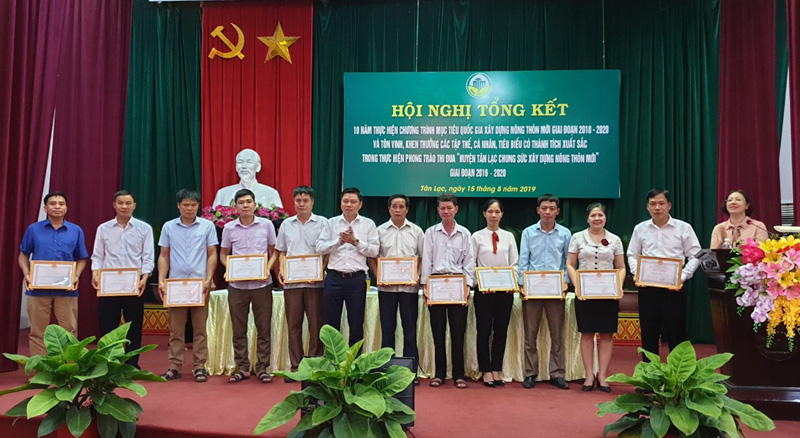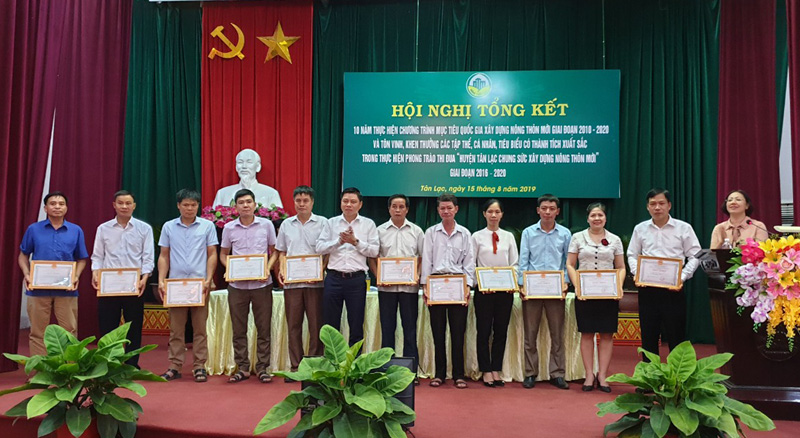
(HBO) – The People’s Committee of Tan Lac held a conference to summarise 10 years of implementing the National Target Programme on New-Style Rural Area Building in the 2010-2020 period.
 Leaders of the Tan Lac
People’s Committee present certificates of merit to individuals with great
contributions to the emulation movement of "Tan Lac district people join hands
in building new-style rural areas” in the 2016-2020 period.
Leaders of the Tan Lac
People’s Committee present certificates of merit to individuals with great
contributions to the emulation movement of "Tan Lac district people join hands
in building new-style rural areas” in the 2016-2020 period.
After 10 years of implementing the Target Programme on
New-Style Rural Area Building, the district has had six communes completing all
the 19 criteria of the programme, bringing the number of average criteria
reached to 12.5 per commune, up 7.03 criteria compared to 2010.
The district has paid special attention to developing
production and forming connectivity chains to produce and sell red-flesh
grapefruits, caged fish, safe vegetable, and Nam Son tangerine.
The locality has supported three cooperatives to join the
commercial goods chain. In 2019, per capita income of the district locals
reached 43.45 million VND (1,868 USD) per year, up 17.55 million VND per year
compared to that in 2010. The poverty rate was brought down to 19.66 percent in
2018 from 39.95 percent in 2010.
For the 2021-2025 period, the district sets major targets,
including 10 communes recognised as new-style rural area, two communes reaching
the advanced criteria for new-style rural areas, and 10 villages and three
communes becoming model new-style rural area.
Per capita income is expected to top 65 million VND per
year, while the poverty ratio is hoped to be reduced to 15 percent, and the rate
of trained labour is set to reach over 65 percent.
The district will strive for 97 percent of locals joining
health insurance, and over 40 percent accessing safe water. At the same time,
the locality will ensure and improve the quality of new-style rural area
criteria. It is estimated that the district will need over 1.02 trillion VND
for the programme in the 2021-2025 period. It has given seven groups of tasks
and solutions to complete the goals.
On the occasion, the People’s Committee of Tan Lac presented
certificates of merit to 11 outstanding collectives as well as 24 individuals
and households in the movement of "Tan Lac district people join hands in
building new-style rural areas” in the 2016-2020 period./.
According to data from the Hoa Binh Provincial Party Committee, the industrial production index for the first six months of 2025 is estimated to have increased by 20% compared to the same period last year. This marks the highest year-on-year growth rate for this period since 2020.
In the first six months of 2025, Hoa Binh province’s export turnover was estimated at 1.145 billion USD, marking an 18.11% increase compared to the same period in 2024. Import turnover was estimated at $ 804 million, a 17.15% increase, which helped the province maintain a positive trade balance.
The lives of the ethnic minority farmers in Tan Lac district have gradually improved thanks to the new directions in agricultural production. This is a testament to the collective strength fostered through the professional associations and groups implemented by various levels of the district’s Farmers’ Union.
With the motto the "product quality comes first,” after nearly one year of establishment and operation, Muong village’s Clean Food Agricultural and Commercial Cooperative, located in Cau Hamlet, Hung Son Commune (Kim Boi district), has launched reputable, high-quality agricultural products to the market that are well-received by consumers. The products such as Muong village’s pork sausage, salt-cured chicken, and salt-cured pork hocks have gradually carved out a place in the market and they are on the path to obtaining the OCOP certification.
In the past, the phrase "bumper harvest, rock-bottom prices" was a familiar refrain for Vietnamese farmers engaged in fragmented, small-scale agriculture. But today, a new spirit is emerging across rural areas of Hoa Binh province - one of collaboration, organisation, and collective economic models that provide a stable foundation for production.
Maintaining growing area codes and packing facility codes in accordance with regulations is a mandatory requirement for agricultural products to be eligible for export. Recently, the Department of Agriculture and Environment of Hoa Binh province has intensified technical supervision of designated farming areas and packing facilities to safeguard the "green passport" that enables its products to access international markets.



 Leaders of the Tan Lac
People’s Committee present certificates of merit to individuals with great
contributions to the emulation movement of "Tan Lac district people join hands
in building new-style rural areas” in the 2016-2020 period.
Leaders of the Tan Lac
People’s Committee present certificates of merit to individuals with great
contributions to the emulation movement of "Tan Lac district people join hands
in building new-style rural areas” in the 2016-2020 period.